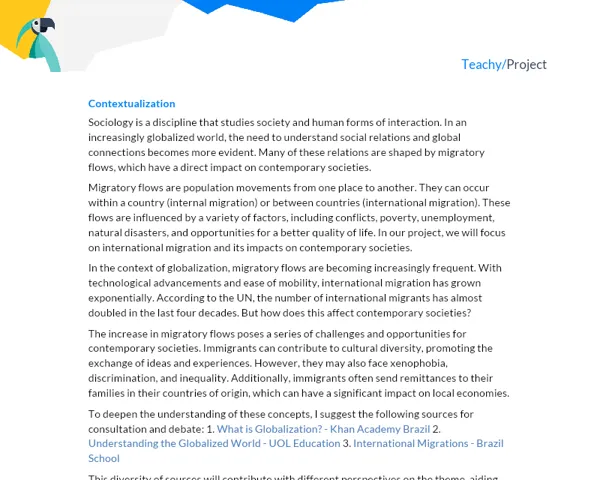Contextualization
Building the State is a fundamental topic to understand the world we live in. States are political entities that exercise sovereignty over a defined territory and the population residing in it. They are responsible for implementing laws, ensuring security, providing public services, and acting to promote social and economic justice. Understanding how States were formed and how they function is crucial for active and informed citizenship.
In the 17th century, Thomas Hobbes and John Locke, two influential political philosophers, each proposed theories on how States were constituted. Hobbes, in his book 'Leviathan,' argued that man, in his natural state, lived in a constant state of war, where life was 'solitary, poor, nasty, brutish, and short.' To overcome this, men made a social contract, agreeing to submit their freedom to a sovereign in exchange for protection and security. On the other hand, Locke in 'Second Treatise of Government' argued that the natural state of men is one of freedom and equality, and that the State emerged to protect man's natural rights - life, liberty, and property.
Importance of State Building
State building and the study of its formation are key components for understanding our current society. Through this study, we can understand the different theories about State formation, shedding light on governance, power, civil rights, and international relations issues. More than that, these theories provide us with a means to analyze and criticize the actions of our own governments and others around the world.
Understanding State building is also crucial for perceiving the existing inequalities and conflicts in today's society. For example, understanding how borders were drawn and States formed can provide insights into ethnic, religious, and territorial conflicts. Furthermore, examining the evolution of the State and social contract theories can help inform debates on issues such as immigration, civil rights, and the role of the State in the economy.
Practical Activity: State Building Simulation
Project Objective
By the end of this activity, it is expected that students will be able to understand and explain the main ideas and characteristics in the construction of the modern State, especially in light of Hobbes and Locke's theories. Additionally, it is expected that students use the simulation as a means to learn how negotiation, compromise, and consensus can be used to form a State.
Project Description
Students will form groups of 3 to 5 people. Each group will represent a population that is seeking to form a State. In doing so, they will simulate the decision-making process that may have occurred during the formation of the State.
The groups will then discuss, negotiate, and reach a consensus on key issues that must be resolved during the formation of the State, including: the formation of laws, the organization of governmental powers, and the design of public policies. Each group will present their 'State' in the form of a Constitution, which will be the main project deliverable.
Required Materials
- A laptop or tablet with internet access for research.
- Paper and pens for note-taking and drawing.
- Access to reference resources, such as books and online tutorials to conduct research.
Project Steps
-
Group Formation: Form groups of 3 to 5 students. The group size should depend on the class size and time availability. Larger groups may require more time for discussions and negotiations.
-
Reference Study: Give groups time to review the recommended resources, as well as other resources they may find. Encourage them to take notes on key concepts and ideas.
-
Brainstorming: Each group should brainstorm based on the information they have collected. This may involve discussions about the type of State they would like to create, the main problems they would face, and potential solutions.
-
Negotiation: Discussions should lead to a negotiation period. Here, students should try to reach an agreement on the laws that will govern their State, the government structure, among others.
-
Constitution Drafting: Once decisions have been made, groups should start drafting a Constitution for their State. This should include all discussed aspects and should be a written document.
-
Review: Finally, groups should review the Constitution, ensuring that all group members agree with it. If necessary, more negotiations and discussions can be held.
Project Deliverables
-
The Constitution: Each group will have to deliver a Constitution that represents the form, laws, and properties of their State.
-
Written Report: Additionally, each group should prepare a written report addressing the following topics:
-
Introduction: Students should contextualize the theme of State building and explain its relevance in the real world. They should also describe why they chose the type of State they created.
-
Development: Here, students should explain the main theoretical concepts they used for the construction of their State. They should detail the step-by-step activities and methodologies used, as well as present and discuss the results obtained.
-
Conclusions: Students should conclude the work by summarizing their main points, the learnings obtained, and the conclusions drawn from the project.
-
Bibliography: Students should indicate the sources consulted during the project execution.
-
The time dedicated to the project may vary, but it is estimated to be between five to ten hours per student. Groups will have one month to complete the project.
This project will not only help assess students' knowledge on the topic of State building, but also their collaboration and teamwork skills, which are crucial for personal and professional life.

